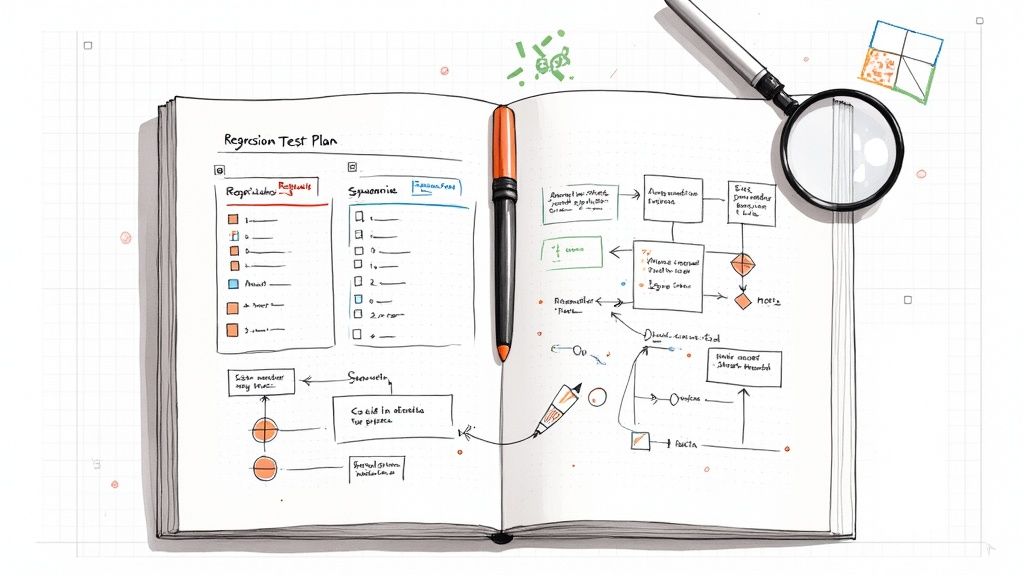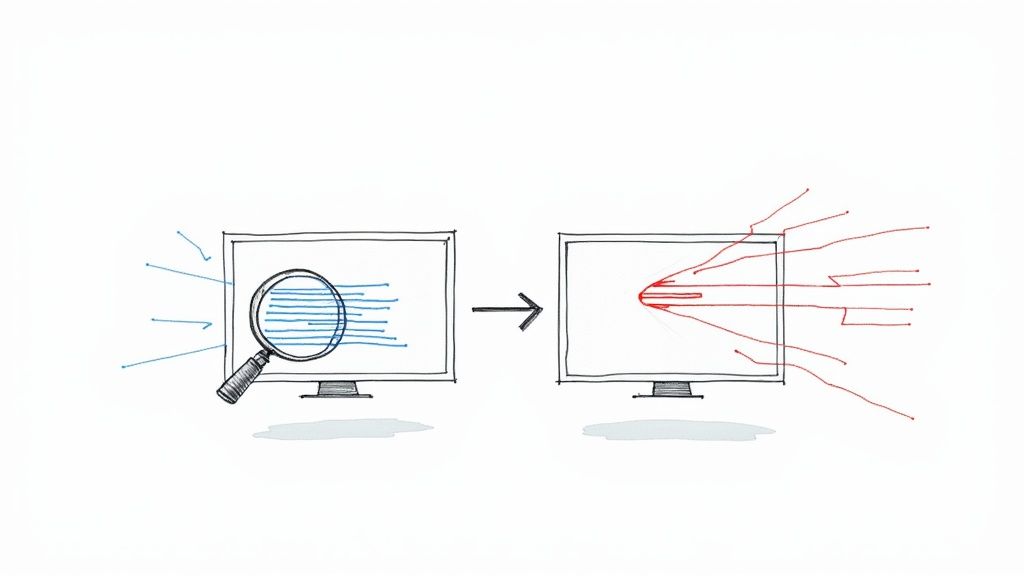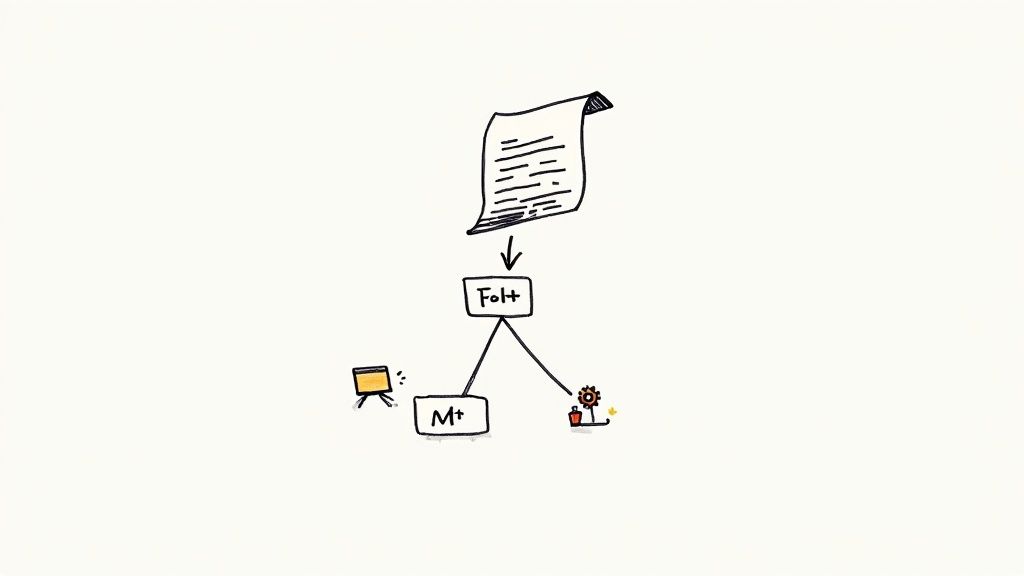Regression Test Planning Guide: Tips for Success

Getting Started With Regression Test Planning Fundamentals

Regression test planning forms the foundation of reliable software development. It's the process of strategically deciding what needs testing, the optimal timing for these tests, and the most effective testing methods. The aim is to guarantee that new code updates haven't inadvertently affected existing features.
A well-structured regression test plan empowers teams to release updates frequently and with confidence, minimizing the chances of bugs making it into production. This leads to fewer disruptions for users and helps maintain their trust in the software's reliability. So, what makes a regression test plan effective, and how can teams begin?
Understanding the Core Principles of Regression Testing
Effective regression test planning begins with grasping the core principles of regression testing. It's not about retesting absolutely everything after every single code change. While thorough, that approach is seldom practical due to time and resource limitations.
Instead, regression test planning concentrates on optimizing test coverage. This is achieved by prioritizing the most critical and vulnerable parts of your application. This might involve recently altered code, essential features, or areas with a history of bugs. For more on this, check out this article on automated regression testing.
Regression testing is vital to make sure updates and bug fixes don’t unintentionally create new issues. Historically, this was resource-intensive, often depending on manual testing. However, the growing use of automation is changing how regression testing is done.
By 2025, projections suggest 50.5% of tests will be automated, demonstrating a shift towards reducing manual work and increasing test coverage. Further statistics are available here. This move towards automation provides significant advantages, like quicker test execution and more comprehensive testing.
Key Components of a Regression Test Plan
A good regression test plan has several crucial elements:
- Scope Definition: Clearly outline the features and functions included in regression testing.
- Test Case Selection: Pinpoint and prioritize the test cases for execution. This means considering factors like risk level, impact on the business, and the chance of regression.
- Test Environment: Detail the environment for testing, ensuring it closely resembles the production environment.
- Schedule and Resources: Create a realistic timeline for test execution and assign the required resources, such as staff and tools.
- Entry and Exit Criteria: Define the exact conditions for starting and ending regression testing, ensuring a structured, controlled process.
By carefully considering these components, teams can create a regression test plan that's thorough yet manageable. This maximizes the value of testing while staying within resource constraints. These fundamentals lay the groundwork for a testing framework that adapts to the changing needs of software development.
Building Your Regression Test Planning Framework That Works
Building a robust regression test plan isn't about filling in a generic template. It's about creating a framework that addresses your application's unique needs and complexities. This means understanding how to identify key test scenarios, prioritize them effectively, and define clear criteria for success. This section presents a practical approach to regression test planning, drawing on the experience of successful QA managers.
Identifying and Prioritizing Test Cases
Effective regression test planning begins with pinpointing the most critical aspects of your application. This involves understanding which functionalities are core to your business, have a history of bugs, or are prone to regressions after code changes. For instance, in an e-commerce platform, the checkout process is paramount, demanding more rigorous testing than less vital features like product reviews.
Prioritization is equally crucial. Not every test case carries the same weight. A risk-based approach, where tests are prioritized by the potential impact of failure and the likelihood of it happening, is often most effective. This lets you concentrate resources on the most important areas, ensuring maximum impact within a realistic timeframe.

The infographic above illustrates a simplified test case prioritization process. Test cases are categorized as "Critical," "Major," and "Minor," with checkmarks indicating those selected for the regression suite. This visualization demonstrates how teams can strategically choose the most important test cases based on their potential impact. This approach helps avoid an excessively large test suite and ensures efficient resource allocation.
Establishing Clear Entry and Exit Criteria
A well-defined regression test plan needs clear entry and exit criteria. Entry criteria specify the prerequisites for starting regression testing. These could include successful completion of unit and integration testing, a stable build, or a ready test environment. Exit criteria, on the other hand, define the conditions signaling the completion of regression testing. These typically involve achieving a specified test coverage percentage, a predetermined pass rate for test cases, or the resolution of all critical bugs. Clearly defined criteria bring structure and transparency to the process.
Structuring and Maintaining Your Test Plan
The structure of your regression test plan document is vital for clear communication and collaboration. A well-structured plan should encompass the following:
- Scope: Clearly define the features and functionalities covered.
- Test Cases: List the chosen test cases, including their descriptions, expected outcomes, and priority levels.
- Environment: Detail the testing environment, covering hardware, software, and configurations.
- Schedule: Outline the testing timeline, including key milestones and deadlines.
- Resources: Identify the resources needed, like personnel, tools, and budget.
Maintaining and updating the plan is just as important. As your application evolves, so should your regression test plan. This involves regular review and updates to the test cases, adapting to new features, and removing obsolete tests. This prevents an overgrown test suite and ensures your regression testing remains relevant and effective. This proactive approach allows your framework to adapt alongside your application's development.
The following table summarizes different test case prioritization methods:
Test Case Prioritization Matrix
| Prioritization Method | Key Criteria | Time Investment | Best Scenarios | Coverage Level |
|---|---|---|---|---|
| Risk-Based | Impact and likelihood of failure | Moderate | Complex applications with limited resources | Focused on high-risk areas |
| Business Priority | Alignment with business goals | Low | Projects with clear business objectives | Prioritizes essential functionalities |
| FIFO (First In, First Out) | Order of test creation | Low | Simple applications with limited change | Broad, but may not focus on critical areas |
This table compares various prioritization approaches, highlighting their key criteria, the required time investment, the situations where they are most effective, and the level of test coverage they offer. Choosing the right method is crucial for maximizing the effectiveness of your regression testing efforts.
Smart Test Case Selection And Risk Assessment Strategies

Effective regression test planning relies heavily on smart test case selection and a robust risk assessment. This involves understanding the value of each test and concentrating on areas prone to issues. The key is not exhaustive testing, but strategic testing.
Identifying High-Risk Areas
The first step is pinpointing high-risk areas within your application. Several factors contribute to this identification. Areas with a history of bugs, recent code modifications, and complex functionalities are often prime candidates for rigorous testing. Essential business features, such as an e-commerce site's checkout process, should always be prioritized.
This targeted approach optimizes limited resources. By focusing on areas susceptible to regressions, you maximize the impact of your testing. This forms the basis of a more efficient and effective regression test plan.
Assessing Business Impact
After identifying potential problem areas, assessing the business impact of potential failures is crucial. This transcends technical aspects and examines how software failures might affect revenue, customer satisfaction, or regulatory compliance. This context is vital for test case prioritization.
A minor bug in a rarely used feature might have a lower business impact than a seemingly small glitch in the core user flow. This understanding informs decisions about which test cases require immediate attention.
Test Case Categorization and Maintenance
Categorization is a practical approach to smart test case selection. Group similar test cases based on functionality, risk level, or execution frequency. This organization simplifies test suite management and enables targeted regression testing based on specific changes.
Legacy test maintenance presents an ongoing challenge. Regularly review your test suite to remove redundant or outdated tests. This prevents test suite bloat, keeping regression testing focused and efficient. Like code refactoring, test case refactoring is essential for a healthy regression test plan.
Frameworks for Decision-Making
Clear frameworks are essential for confident decisions about test inclusion and exclusion. A well-defined risk assessment matrix, for instance, can guide these decisions, assigning numerical values to the likelihood and impact of potential failures. This provides quantifiable data for prioritization, justifying decisions to stakeholders.
Establishing clear entry and exit criteria for regression testing adds further structure. These criteria, such as achieving a specific test coverage percentage or resolving all critical bugs, ensure consistency and control in regression testing, leading to a more manageable and effective planning process.
Automation Integration In Regression Test Planning
Modern regression test planning necessitates a strategic approach to automation. It's not about choosing between manual and automated testing. It's about understanding how to effectively integrate automation into your overarching regression testing strategy. This means carefully selecting the right tests to automate, planning for ongoing maintenance, and aligning automation efforts with your long-term testing goals.
Identifying Automation Candidates
The first step is figuring out which test cases are best suited for automation. Ideal candidates include:
- Repetitive Tests: These are tests that are run frequently across different builds or versions.
- Data-Driven Tests: Tests that use multiple data sets and variations are good candidates.
- Smoke and Sanity Tests: These are quick checks of core functionalities.
- Load and Performance Tests: These tests simulate high user loads and measure system response.
- Stable Areas: Target parts of the application that are less prone to frequent changes.
Automating these tests frees up your testers to focus on exploratory testing, usability evaluations, and other tasks that require human judgment. Plus, automation improves testing speed and reduces the risk of human error. You might be interested in: A guide to Continuous Integration Best Practices.
Building a Sustainable Automation Strategy
Building a sustainable automation strategy involves more than just automating tests. It requires planning for maintenance, updates, and the inevitable evolution of your application. This includes:
- Choosing the Right Tools: Select tools that align with your team’s skillset, budget, and the technologies used in your application. Consider popular testing frameworks like Selenium or Cypress.
- Designing Modular Tests: Create reusable test components that can be easily adapted to changes in the application.
- Establishing Clear Processes: Define workflows for test creation, execution, analysis, and maintenance.
This proactive approach prevents automation from becoming a burden, ensuring your automated tests remain valuable assets in your regression testing toolkit. A well-planned automation strategy also supports faster release cycles and reduces technical debt.
Creating an Automation Roadmap
Finally, develop a clear roadmap for implementing automation. This roadmap should outline:
- Short-Term Goals: Define which tests will be automated first and the expected benefits.
- Long-Term Vision: Articulate the ultimate goal of automation and how it contributes to your overall testing objectives.
- Resource Allocation: Outline the budget, personnel, and training required for successful automation.
- Metrics for Success: Identify Key Performance Indicators (KPIs) to track the effectiveness of your automation efforts.
A well-defined roadmap ensures automation aligns strategically with your organizational goals. This maximizes its impact on regression test planning and overall software quality. For example, reports show that by 2025, 46% of teams expect to automate 50% or more of their manual testing. Find more detailed statistics here.
Navigating Market Trends and Tool Selection for Testing Success
The regression testing landscape is constantly evolving, making informed tool choices crucial for successful regression test planning. Choosing the wrong tools can waste resources and derail your testing efforts. This section explores current market trends influencing regression test planning and offers practical advice on selecting the right tools for your needs and budget.
Market Growth and Tool Development
The increasing demand for reliable software fuels rapid growth in the regression testing market. This growth drives innovation in testing tools, with vendors constantly adding new features and functionalities. The emphasis on faster release cycles and continuous delivery is pushing the development of tools that support automated testing and integration with CI/CD pipelines. Planning for regression testing now involves considering how well tools integrate with your existing development ecosystem.
This market expansion also means more choices, making selection more complex. It's crucial to evaluate tools based on your specific requirements, not just the most popular or feature-rich solution. Learn more about the regression testing service market's growth here. The global market is expected to see a compound annual growth rate (CAGR) from 2025 to 2033. This growth is driven by factors like digital transformation, automation, and the need for faster, more efficient testing.
Evaluating Tools Beyond the Demo
Effective tool evaluation goes beyond flashy demos. It requires a deep dive into a tool's capabilities and how they align with your testing needs. Consider factors like:
- Ease of use
- Scalability
- Integration with other tools
- Reporting capabilities
- Vendor support
When exploring automation integration in regression test planning, consider how you might also leverage automation to automate customer service.
Total Cost of Ownership
Understanding the total cost of ownership is crucial. Beyond the initial price, consider the costs associated with:
- Training
- Maintenance
- Updates
- Potential vendor lock-in
Open-source tools might seem appealing initially but often require significant investment in internal expertise and ongoing maintenance. Proprietary tools often offer more comprehensive features and support, but they come with licensing fees and potential vendor dependencies.
Aligning with Future Growth
Your tool choices should align with your current needs and future growth plans. Choose tools that can scale with your application's complexity and team size. Consider factors like:
- The tool's ability to support different testing types
- Integration with various platforms
- The availability of skilled resources to manage the tool
Avoiding vendor lock-in is also important, giving you flexibility if your needs change.
By carefully considering these factors, you can navigate market trends effectively and make informed tool selection decisions. This ensures your regression test planning process remains effective, efficient, and aligned with your overall development goals.
Learning From Global Regression Test Planning Approaches
Regression test planning is a complex process, and its execution varies significantly across different regions and industries. Examining these diverse approaches offers valuable insights that can be adapted and applied to improve your own testing strategies.
Regional Differences in Testing Methodologies
North America, with its strong emphasis on research and development, often leads the way in innovative testing practices. The adoption of new automation frameworks and risk-based testing methodologies is common. For instance, the region frequently pioneers new approaches, offering valuable learning opportunities for organizations worldwide. Choosing the correct tools is also essential for effective test planning; resources like this guide to essential SEO tools can be beneficial.
The Asia-Pacific region, marked by its rapid technological advancement, focuses on speed and efficiency. The widespread adoption of Agile and DevOps practices has led to advancements in continuous testing and delivery. These practices offer valuable lessons in optimizing regression test planning for quicker release cycles.
Europe prioritizes compliance and sustainability in its testing practices. Regulations such as GDPR heavily influence how test data is managed and how privacy is maintained throughout the testing process. These considerations are becoming increasingly crucial for global organizations.
The regression testing tool market is experiencing significant growth in both North America and Asia-Pacific. North America's robust industrial infrastructure and extensive R&D contribute to this growth. Asia-Pacific, particularly countries like China, Japan, and India, is seeing rapid industrialization and urbanization, further boosting the adoption of these tools. Projections indicate these regions will maintain their leading positions by 2032. North America will continue to build upon its existing infrastructure, while Asia-Pacific will leverage rapid technological advancements. Explore this topic further.
To further illustrate the regional variations, the following table provides a comparison of regression testing approaches.
The table below, "Regional Testing Approach Comparison," outlines the differences in focus areas, tool preferences, and key drivers for success across major regions. This comparison highlights how regional factors influence testing strategies.
| Region | Primary Focus | Preferred Tools | Key Drivers | Success Metrics |
|---|---|---|---|---|
| North America | Automation and Risk-Based Testing | Selenium, Appium, JUnit | Innovation and Speed | Test Coverage, Defect Rate, Time to Market |
| Asia-Pacific | Agile and DevOps, Continuous Testing | Jenkins, GitLab CI, Selenium | Efficiency and Scalability | Release Velocity, Deployment Frequency |
| Europe | Compliance and Security Testing | SonarQube, OWASP ZAP | Regulatory Compliance, Data Privacy | Compliance Adherence, Security Vulnerability Rate |
Key observations from the table include North America's emphasis on automation and risk assessment, Asia-Pacific's focus on speed and scalability through Agile and DevOps, and Europe's prioritization of compliance with regulations like GDPR.
Adaptable Best Practices
Despite these regional differences, several best practices apply universally:
- Risk-Based Testing: Prioritizing tests based on potential impact and likelihood of failure.
- Clear Communication: Maintaining open communication among testers, developers, and stakeholders.
- Continuous Improvement: Regularly reviewing and improving testing processes based on data and feedback.
Tailoring Approaches to Your Context
While learning from global best practices is valuable, adapting these lessons to your organization's specific needs is crucial. The most effective approach depends on several factors:
- Team Structure: Distributed teams might require different tools and communication strategies compared to co-located teams.
- Application Type: The complexity and criticality of the application will influence the intensity and frequency of testing.
- Industry Regulations: Compliance needs often dictate specific testing procedures and data management practices.
By carefully considering these factors and applying relevant global best practices, you can create a tailored and effective regression test planning process. Adaptability is essential for long-term success in a constantly evolving development landscape.
Your Implementation Roadmap And Success Metrics That Matter
Turning your regression test planning know-how into tangible results requires a clear, actionable plan. This section provides practical steps for putting best practices into action, no matter your current testing maturity. You’ll learn how to measure the true effectiveness of your regression test planning with meaningful metrics that demonstrate real value. We'll also explore how to introduce new processes, manage pushback, and continuously improve your testing strategy based on performance data.
Rolling Out Your Regression Test Plan
Implementing a new regression test plan is more than just writing a document. It requires a strategic approach to ensure acceptance and smooth execution. Start by clearly communicating the plan's purpose and benefits to everyone involved, from developers to business leaders. This transparency builds understanding and encourages teamwork.
Next, pilot the plan on a smaller project or feature before a full rollout. This lets you identify potential obstacles, refine processes, and demonstrate the plan's value in a controlled environment. This measured approach reduces risk and gathers valuable data for future improvements.
Provide adequate training and support to your team throughout implementation. This empowers testers with the skills and knowledge to effectively execute the plan. Regular check-ins and feedback sessions facilitate communication and address any concerns. Learn more in our article about How to Master Test Case Writing.
Managing Change Resistance
Introducing new processes often meets resistance. Address concerns openly and proactively. Highlight the advantages of improved software quality, fewer production bugs, and faster release cycles. Show how the plan streamlines testing, lessening workload and boosting overall efficiency.
Involve team members in the implementation process. Their input can lead to valuable enhancements and creates a sense of ownership. By addressing resistance directly, you promote buy-in and create a smoother transition.
Measuring Success: Metrics That Matter
Measuring your regression test plan's effectiveness requires focusing on metrics that demonstrate real impact. These should go beyond simple pass/fail rates and offer insights into how well the plan supports your development goals.
Consider metrics like:
- Defect Escape Rate: Monitor how many bugs reach production after regression testing. This indicates how effectively your testing catches important issues. A lower escape rate signifies better quality.
- Test Coverage: Calculate the percentage of the application covered by your regression tests. This reveals how thoroughly your tests address potential problem areas.
- Test Execution Time: Record how long it takes to finish a full regression test cycle. Use this data to pinpoint areas for improvement and optimize testing efficiency.
- Time to Resolve Defects: Measure how quickly found bugs are fixed. This reflects the efficiency of your communication and bug-fixing processes.
Tracking these metrics provides valuable data for continuous improvement. Analyzing trends can highlight strengths and weaknesses in your regression test planning.
Continuous Improvement
Regression test planning is not a one-time task. It demands ongoing evaluation and refinement. Regularly review your test plan, examining performance data and gathering feedback from your team. Identify areas for improvement, such as optimizing test cases, refining risk assessments, or improving automation strategies.
By embracing continuous improvement, you keep your regression test plan relevant, effective, and aligned with your evolving development goals. This constant adaptation is crucial for maximizing software quality and supporting rapid release cycles.
Ready to improve your development workflow and enhance code quality? Explore how Mergify can help automate your pull request management and boost your CI/CD pipeline. Visit Mergify today to learn more.





